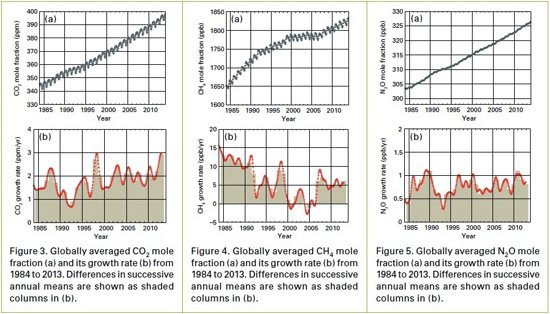Nitrous Oxide (N2O)
Nitrous oxide is emitted into the atmosphere from both natural (about 60%) and anthropogenic sources (approximately 40%), including oceans, soil, biomass burning, fertilizer use, and various industrial processes. Its atmospheric concentration in 2013 was about 325.9 parts per billion. Its impact on climate, over a 100-year period, is 298 times greater than equal emissions of carbon dioxide. It also plays an important role in the destruction of the stratospheric ozone layer which protects us from the harmful ultraviolet rays of the sun.
Ocean Acidification
For the first time, this Bulletin contains a section on ocean acidification prepared in collaboration with the International Ocean Carbon Coordination Project (IOCCP) of the Intergovernmental Oceanographic Commission of UNESCO (IOC-UNESCO), the Scientific Committee on Oceanic Research (SCOR), and the Ocean Acidification International Coordination Centre (OA-ICC) of the International Atomic Energy Agency (IAEA).
The ocean currently absorbs one-fourth of anthropogenic CO2 emissions, reducing the increase in atmospheric CO2 that would otherwise occur because of fossil fuel combustion. Enhanced ocean CO2 uptake alters the marine carbonate system and lead to increasing acidity. The ocean’s acidity increase is already measurable as oceans take up about 4 kilogrammes of CO2 per day per person.
The current rate of ocean acidification appears unprecedented at least over the last 300 million years, based on proxy-data from paleo archives. In the future, ocean acidification will continue to accelerate at least until mid-century, based on projections from Earth system models.
The potential consequences of ocean acidification on marine organisms are complex. A major concern is the response of calcifying organisms, such as corals, algae, mollusks and some plankton, because their ability to build shell or skeletal material (via calcification) depends on the abundance of carbonate ion. For many organisms, calcification declines with increased acidification. Other impacts of acidification include reduced survival, development, and growth rates as well as changes in physiological functions and reduced biodiversity.
Click here to read/download the Full Bulletin.
Source: WMO.
The WMO Global Atmosphere Watch Programme (www.wmo.int/gaw) coordinates systematic observations and analysis of greenhouse gases and other trace species. Fifty countries contributed data for the Greenhouse Gas Bulletin. Measurement data are reported by participating countries and archived and distributed by the World Data Centre for Greenhouse Gases (WDCGG) at the Japan Meteorological Agency. (http://ds.data.jma.go.jp/gmd/wdcgg)















